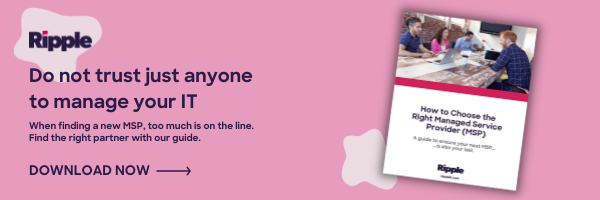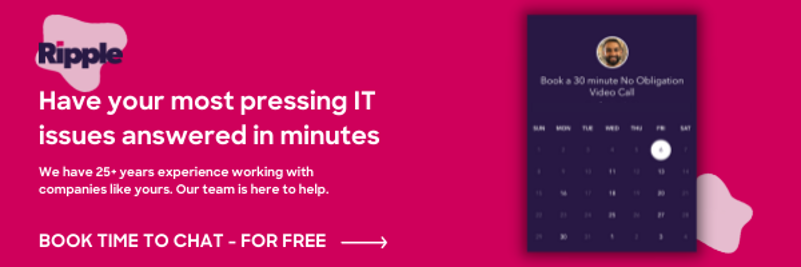
The support experience is the most utilized interaction between your organization and your IT managed service provider. It touches everyone throughout the organization, so it shapes your team’s attitudes and feelings about the current IT Support Service.
Remember managed service providers (MSPs) do about 90% the same things. For support this means tools, technologies and communication platforms. So what are examples of the 10% you can look for to help find the best possible IT partner for your organization?
Before we review each in depth, here are a couple of industry metrics to keep in mind. Both have been consistent for 3 years running.
- The top 2 issues that MSPs have reported are a lack of time and difficulty hiring good employees.
- The majority of the industry needs 3 months for a helpdesk technician to be 80% effective.
Leadership
Very few IT service organizations have a dedicated leader who watches over the IT support service delivery. On many technical teams, the most seasoned engineer on the team fills the role of part time support manager. In smaller firms, this tends to be one of the owners; in other words, a person with a lot of other hats to wear.
This leadership model leads to inconsistent management that typically reacts (late) to client service issues. The more an MSP’s clients are having issues, the more that MSP has to manage the helpdesk. When things are going well there is little or no management.
So what becomes inconsistent without a dedicated support manager?
Culture – technical people have a tendency to follow the lead of the most senior person on their team.
This can have disastrous consequences for 2 reasons:
- Technicians earn stripes with all-nighters and heroic saves. For a client this translates to frustration when something blows up and then a hero swooping in to save the day.
- A significant number of technically brilliant people lack empathy for user issues they deem “simple” or “stupid”.
Neither is optimal for a team that focuses on helping people. Safeguarding the culture of a helpdesk is a full time job and extremely important to good outcomes.
Key Performance Indicators (KPIs) – support is a well defined activity.
A good set of KPIs can keep a team on track. Good KPIs also allow a manager to make adjustments, escalate repetitive issues, and refine the client experience. Any team should look at their KPIs regularly in order to reap maximum benefit.
What can you do with this information? Ask your current or future IT partner the following:
- Describe the leadership structure for the support team.
- Find out whether the leader of the support team has other responsibilities.
- Ask about the KPIs the support team tracks. See what metrics they give you first, but we suggest looking for metrics like:
- Average time to user ticket resolution – focusing on user tickets should remove any system generated tickets that auto close and dilute the metric.
- Average daily user ticket volume – this metric you should be able to get an idea of how stretched the support team is when used in conjunction with the average time to resolution.
- Ask about how the IT support service team is evaluated and how often are they given feedback?
Structure
Structure is complicated because of the inconsistency of what MSPs say they support. Let’s take a deep look at how your IT partner should be organized internally to deliver the most consistent support results.
First, let’s consider how MSPs describe what they support.
Endpoints – This is typically workstations, laptops and servers (physical and virtual)
Devices – This is all endpoints plus network (e.g. wireless, firewalls, etc…) and IoT devices (e.g. TVs, printers, phones, etc…)
Users – People (includes their primary laptop/workstation)
Now that you know how we describe what we support you should look for the following:
The Dedicated User Support Team is a subset of the overall support team that is committed to supporting users. This can be done on a rotational basis, but the result you want to see is that every day X support team members are dedicated to supporting people.
Clear Escalation Path to a Dedicated Team Member – Sometimes user issues take longer or are more technical than originally thought. There needs to be a dedicated escalation point on the support team. Most of the time in smaller IT companies the escalation point will be a senior engineer that has many technical responsibilities outside of support, andhat leads to an inconsistent escalation experience based on that person’s workload.
How can you use this information?
- Ask your IT partner about the structure of the helpdesk. Find out if the support team folks are dedicated to the helpdesk and whether they support people, endpoints, or both. What you are really looking for is whether the helpdesk has people dedicated to helping people.
- Find out how escalations are handled. Specifically, find out if they use time based metrics or if this is a manual technician driven process. Either will work, but remember the hero we mentioned above. If the culture of the helpdesk is not strong, a support tech might keep working a ticket in order to save face. This result is a poor user experience since the issue takes so long to resolve.
Tactics
This is really a broad term that involves process, continuity and communication. Many tactics can influence the consistency of the helpdesk. Here are 2, that if lacking, will affect the user support experience in a negative way.
1. Clear Outlet for Service Issues – Nothing hurts the relationship between you and your IT partner more than the inability to communicate honestly. If your outlet for service issues is the primary technical resource, the tendency is to let service issues simmer. Eventually this blows up and takes away from all relationships involved.
2. Continuity – A go-to person for your organization’s support sounds like it is the best way to receive a consistent experience. They know your common issues and are able to get resolutions quickly, right? But this breaks the minute that person gets sick, gets too busy, or leaves the company. This is why continuity is so important. The processes of documentation and cross training supports continuity.
How can you use this information?
- Get a clear understanding of the process for communicating IT support service issues including who and how.
- We suggest a single non-technical point of contact like a dedicated account manager.
- A scheduled quarterly meeting works well unless the issues are very acute. Having a dedicated point of contact will really help make things hum.
- Ticket surveys and quarterly long form surveys are a nice touch to keep the communication open, honest, and timely.
- Understand how your organization will be supported.
- How many people will be involved in support?
- How and where will your documentation be kept?
- Can you have access to the documentation?
- Ask about employee churn and the average length of tenure support members have with the company.
Revisiting the industry benchmarks mentioned above:
- The top 2 issues MSPs have reported are lack of time, and difficulty hiring good employees
- The majority of the industry needs 3 months to get a helpdesk technician to be 80% effective.
If your current IT partner does not have proper support leadership or structure in place what are the chances they get that done in the next year?
If MSPs lack time, what are the chances the documentation of your environment will be done (or improve)?
Finally, what happens if they lose the primary technical support person you love dealing with?
Finding a mature IT services provider is a great start to mitigating these potential pitfalls. Having already climbed the mountain of creating a dedicated team with a strong dedicated leader, we are free to refine the tactics of delivering a consistent support experience.
Want to talk more about IT? Book some time with our team today with a free 30-minute consult.
Ripple's IT Team
Don't Fall Behind!
Get the latest work-from-home and Humans First® IT tips straight to your inbox.

